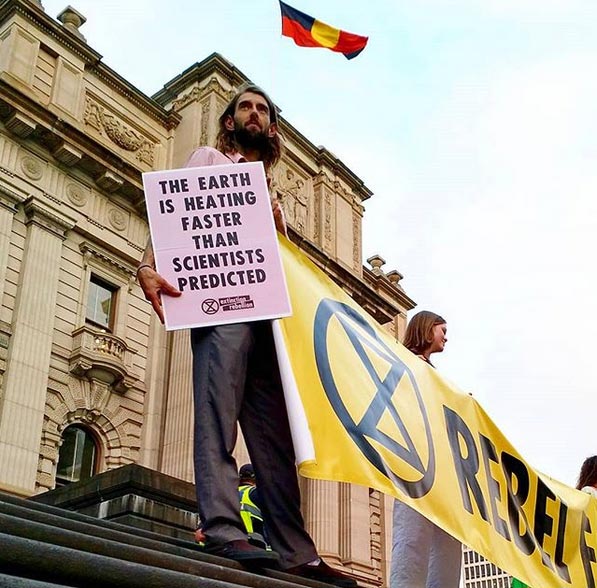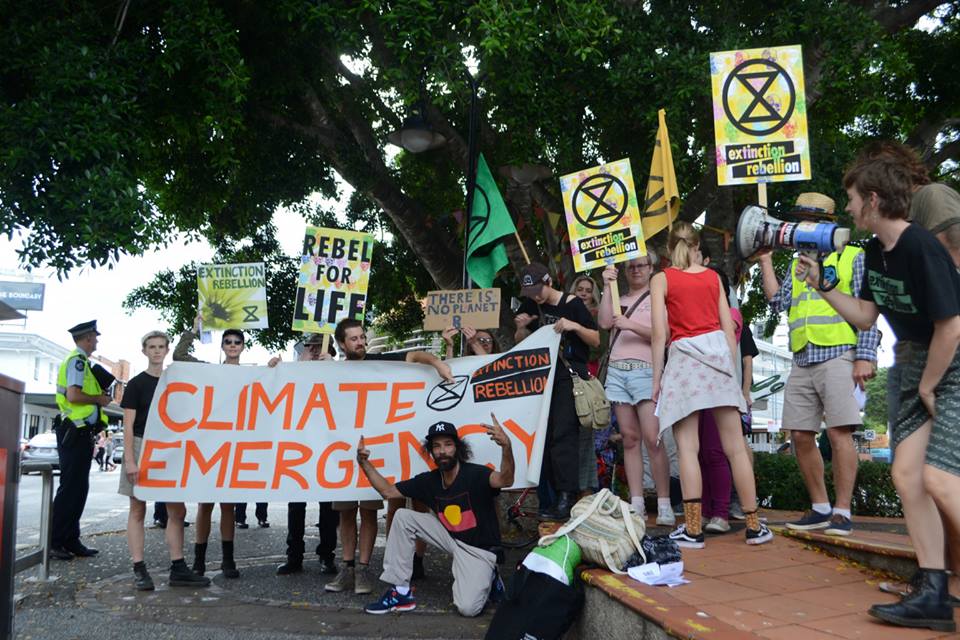
International Rebellion: First Week in Australia
XR Aus, 20 Apr 2019
The first week of international rebellion has kicked off with actions right across Australia
Day one: Monday (15 April)
Australia’s week of international rebellion began with a traffic disruption in Melbourne at 7:30am. A six lane road was blocked intermittently over a period of an hour by about 30 rebels. The traffic blockade allowed bicycles to get a free run into the city where they are usually delayed for long periods at the traffic lights when cars have priority. Traffic was blocked four times, each time for a period of a few minutes, but still created major delays. The police arrived half way through and after some negotiation, allowed the blockade to continue on the basis that police would assist with traffic management. Police joined the rebels on the road and stood between them and the traffic. Check out the video highlights of this action, here.
In Adelaide, South Australia, rebels entered Parliament house while sitting was in process and demanded the declaration of a climate emergency. They were forcibly removed by security. But the story made the evening TV news on two stations.
Sydney rebels staged a ‘die in’ dramatically dropping dead in the streets.
Protesters dropped “dead” in the middle of the busy streets of Sydney, Australia on Monday to highlight the emergency we are all facing due to catastrophic climate change.
It served as a haunting and symbolic demonstration of what we will all face if we don’t drastically slash our carbon emissions in only 10 years: The ‘mass extinction’ of nearly all species on the planet – followed by the deaths of hundreds of millions of people, due to famine, water shortages, increased natural disasters, and ecological collapse. This effects you.
Day two: Tuesday (16 April)

There was a ‘camp out for climate’ event in Melbourne overnight. Around 40 rebels gathered on the steps of Parliament House for a peaceful demonstration before moving to the Treasury Gardens to stay the night.
A special song was sung in support of the London rebels.
Police attended, but allowed the camp to go ahead and even provided support in the form of patrols around the perimeter of the park. This was a great opportunity for rebels to rest, reflect, make new friends and have long discussions. More of these camp-outs are planned, which we hope will gradually grow in number, frequency and size as more people join the campaign.
Day four: Thursday (18 April)
Bob Brown’s Stop Adani convoy headed off from Melbourne to make their way up to Queensland to protest the Adani mine proposal in the Galilee Basin. They will return via Canberra just in time for the last two weeks of the federal election campaign. Several car loads of rebels have gone with them to make the journey.
In Queensland, two rebels occupied coal trains making their way to the Brisbane port. One was on the coal train for over four hours before being arrested. The other occupation took place later that same night and lasted for four hours before arrest.

A peaceful demonstration in Brisbane, Queensland the same day was violently attacked by police. “Six climate rebels were ambushed by the Queensland police services cyber crime and tactical response units moments before the action took place leading to all six being arrested (Some violently with heads being bashed, some having their legs kicked out from underneath them at the hands of police.) Two were charged with offences and four were released with no charge.”
Although not associated with Extinction Rebellion, we stand in solidarity with the brave individuals who showed up at Northern Territory’s parliament with drilling equipment to protest against harmful fracking in the state.
“Traditional owners protesting fracking in the Northern Territory have brought drilling equipment to the front lawns of the Northern Territory’s parliament.
They say they want to let politicians know how it feels to have unwelcome machinery on your land, and that they have not given their consent for gas companies to undertake exploration on their country.
Wednesday marks one year since the Northern Territory government lifted the moratorium on fracking. The moratorium was announced in 2016, shortly after the Labor government took office.”